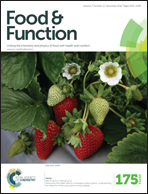Chemical profile and cellular antioxidant activity of artichoke by-products
Abstract
Artichoke by-products, produced from agricultural procedures and the processing industry, represent a huge amount of discarded material. In this research, the main artichoke by-products, bracts and leaves, were characterized in terms of their bioactive constituents (phenolic compounds and inulin) and cellular antioxidant potential to estimate their nutraceutical potential. The ultrahigh-performance-ultraviolet detection-high resolution mass spectroscopy (UHPLC-UV-HRMS) profiles of both by-products show that 5-caffeoylquinic acid and 1,5-dicaffeoylquinic acid are the most abundant bioactive compounds, and the content of flavone glycosides can be used to discriminate between bracts and leaves. Artichoke by-products contain a remarkable overall phenolic content (0.5–1.7 g per 100 g dry matter), whereas they differ widely in the amounts of inulin with higher levels in bracts (3.8–8.2 g per 100 g dry matter). The cellular antioxidant activities of bract and leaf extracts (half maximal effective concentration (EC50) = 26.6–124.1 mg L−1) are better than or similar to that of a commercial leaf extract, and are related to the dicaffeoylquinic acid levels, particularly to 1,5-dicaffeoylquinic acid. These results reveal that artichoke by-products are a promising and cheap source of bioactive compounds. Bracts could be used as a source of inulin and caffeoylquinic acids for the production of food additives and nutraceuticals and also as an alternative to the traditional application of leaf extracts.



 Please wait while we load your content...
Please wait while we load your content...